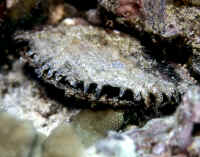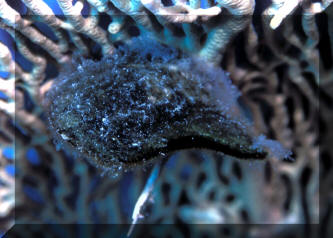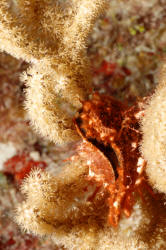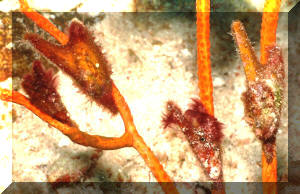|
Related FAQs: Bivalves, Bivalves 2, & Bivalve Identification, Bivalve Behavior, Bivalve Compatibility, Bivalve Selection, Bivalve Systems, Bivalve Feeding, Bivalve Disease, Bivalve Reproduction, Tridacnids, Tridacnid Clam Business, Tridacnid Identification, Tridacnid Selection, Tridacnid Compatibility, Tridacnid Systems, Tridacnid Lighting, Tridacnid Placement, Tridacnid Feeding, Tridacnid Disease, Tridacnid Reproduction, Flame Scallops,
Related Articles: Mollusks, Giant
Clams/Tridacnids,
/The Conscientious Marine
Aquarist
Bivalves: Clams,
Oysters, Mussels... Class Bivalvia, Pt. 2
To: Pt. 1,
Pt. 3
|
|
|
By Bob Fenner
|
|
Pearl Oysters, Family Pteriidae:
| Lopha cristagalli
(Linnaeus 1758), the Cock's Comb Oyster. Indo-West Pacific;
including the Red Sea. Characteristic even opening "zig zag" shells,
and less calcification than Hyotissa above. Can be kept in aquariums lacking
predatory starfishes. Filter feeders that can be serviced by utilizing
timers to shut off filter pumps temporarily. Attach to hard substrates. Fiji
2017 by RobB |
%20MD.JPG)
|
Bigger PIX:
The images in this table are linked to large (desktop size) copies.
Click on "framed" images to go to the larger size. |
MD.JPG) |
Genus Pinctada:
| Pinctada margaritifera (Linnaeus 1758), the Common or Black-Lipped Pearl Oyster. THE pearl oyster of the South Pacific.
Indo-Pacific all the way to the Eastern Pacific, South Africa and the Red
Sea. To almost a foot
in length. Hawai'i pic. |

|
| Pinctada maxima, the
Gold-Lipped Pearl Oyster. West Pacific. To a foot
in length. Bali 2014 |
%20MD.JPG)
|
Genus Pteria:
| Pteria aegyptica (Chemnitz 1782), Egyptian
Wing-Oyster. Indo-Pacific; including Red Sea. Found attached
to gorgonians (as here), stony corals, soft corals, hydrozoans.
Needs strong current, moderate light and very small (less than 15
millimicron diameter) for food. To 8 cm. in length. Red Sea
pic. |

|
Bigger PIX:
The images in this table are linked
to large (desktop size) copies. Click on "framed" images
to go to the larger size. |
|
%20MD.JPG)
|
| Pteria brunnea (Pease 1863), the Winged
Pearl Oyster. Usually found in clusters on whip corals
(Cirrhipathes, Stichopathes spp.) or black coral (Antipathes spp.),
with Bryozoans et al. in turn growing on their shells. Hawai'i
pic. (this may be an endemic) |

|
Bigger PIX:
The images in this table are linked
to large (desktop size) copies. Click on "framed" images
to go to the larger size. |
|
%20MD.JPG)
|
| Pteria colymbus, Atlantic Wing-Oyster. Tropical West
Atlantic. 2-3 inches. Found attached to Gorgonians, mostly Sea
Plumes. Often overgrown in turn by other organisms. Turks
photo. |
.JPG)
|
|
Interested in these verticals for publication?
Please identify by page #, row, column placement and write to
[email protected]
|
 .jpg) |
Bigger PIX:
The images in this table are linked
to large (desktop size) copies. Click on "framed" images
to go to the larger size. |
|


|
Bigger PIX: Pteria tortirostris, Sipadan 08
The images in this table are linked to large (desktop size) copies.
Click on "framed" images to go to the larger size. |
 |
To: Pt. 1,
Pt. 3
|
|

